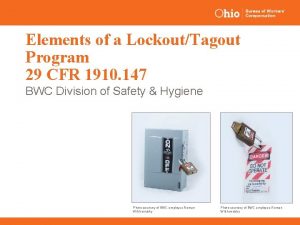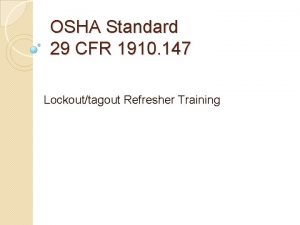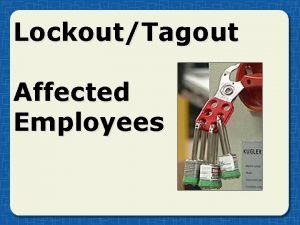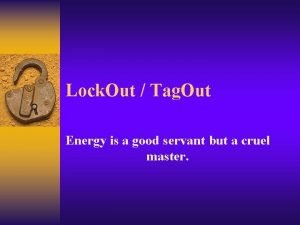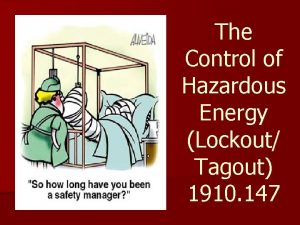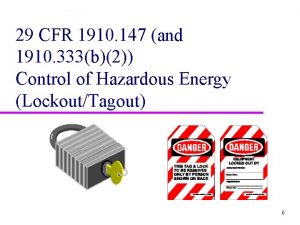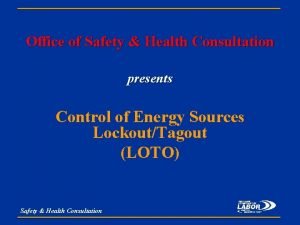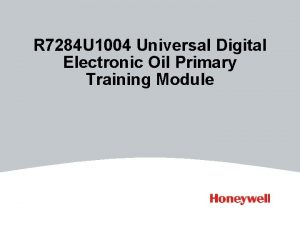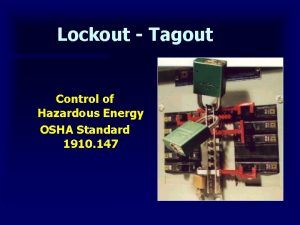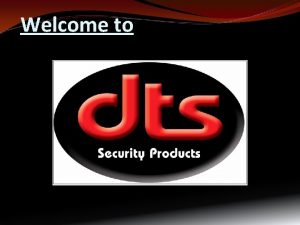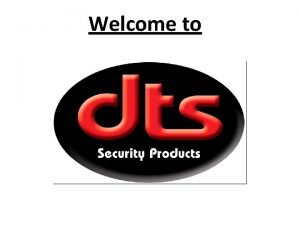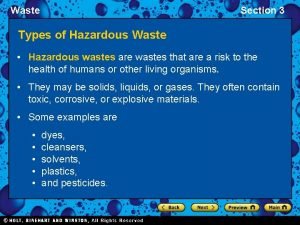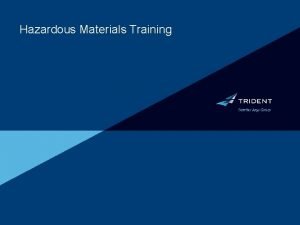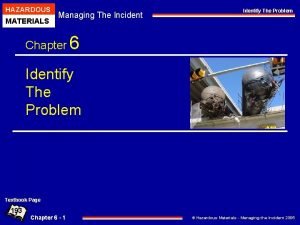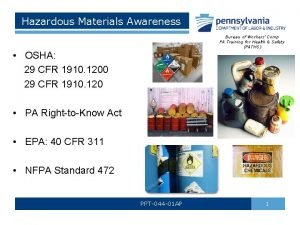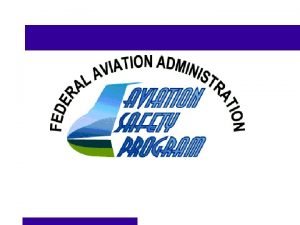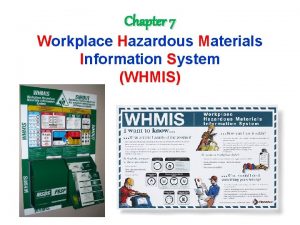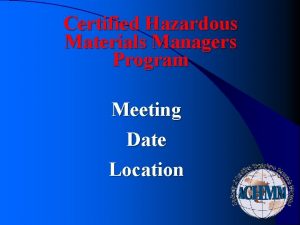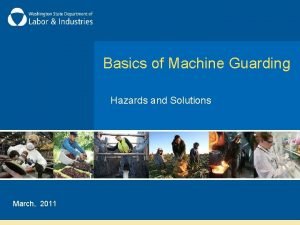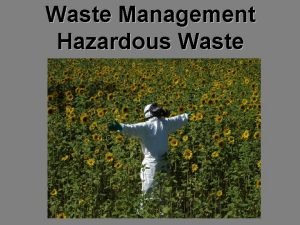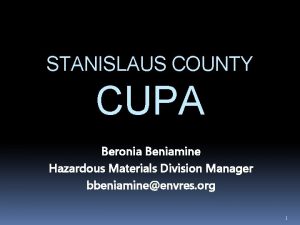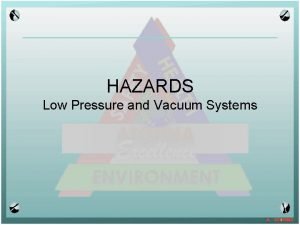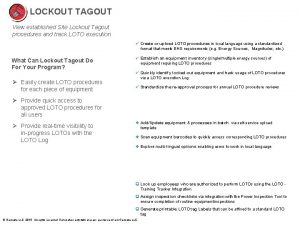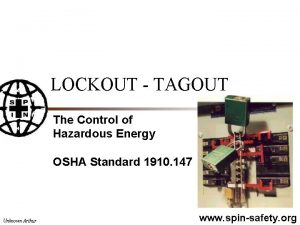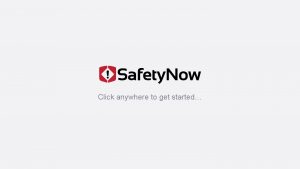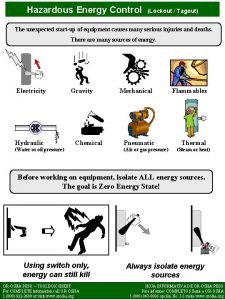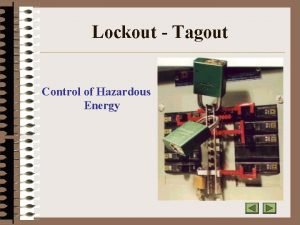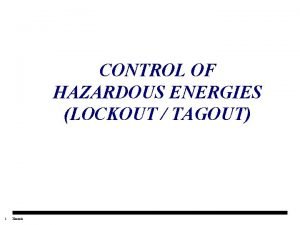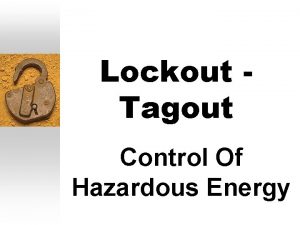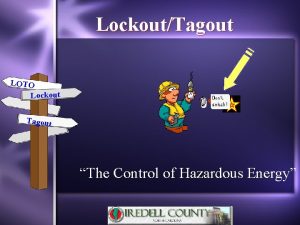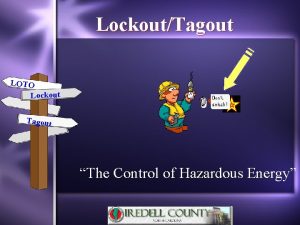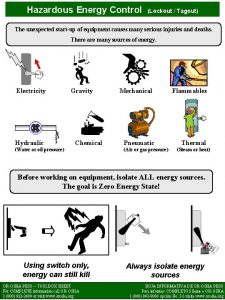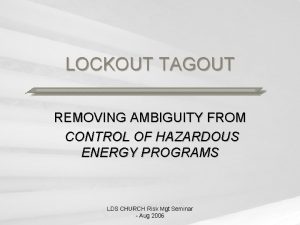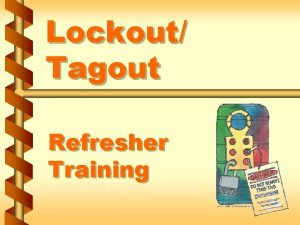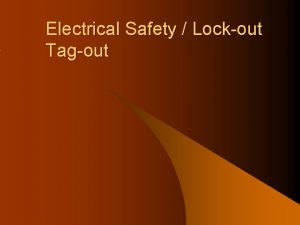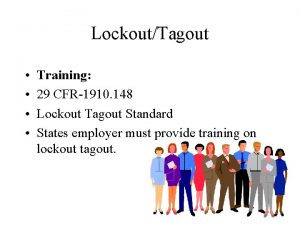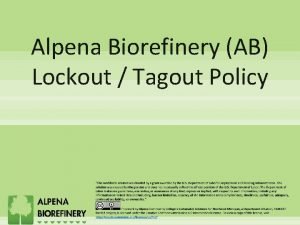OSHA LOCKOUT TAGOUT TRYOUT The Control of Hazardous

































- Slides: 33

OSHA LOCKOUT / TAGOUT / TRYOUT The Control of Hazardous Energy For General Industry Subpart J – General Environmental Controls 29 CFR-1910. 147

Responsibility of Employers ⦿ ⦿ ⦿ ⦿ Create and maintain a lockout / tagout program. Utilize 29 CFR-1910. 147 as the minimum standard Provide an energy control procedure. Provide protective materials and hardware. Provide annual inspection of procedures, materials and hardware, and training implemented within their program. Provide training for lockout / tagout procedures. Maintain documentation for all of the above.

WHY LOCKOUT / TAGOUT / TRYOUT? a. To prevent machinery from being accidentally or mistakenly turned on during cleanup or during maintenance procedures. b. To prevent accidental startup

Reasons for Procedures ⦿ Protect the person working on the apparatus or machinery. ⦿ Protect the workers in the area. ⦿ Protect the equipment. ⦿ Serve as a communication device for the above three elements.

Potential Accidents that can occur ⦿ Electrocution ⦿ Cuts, Punctures, and Abrasions ⦿ Broken Bones ⦿ Severed Body Parts ⦿ Crushed Body or Body Parts ⦿ Loss of eyes or eyesight ⦿ Concussion or Brain Trauma

High Pressure Steam Release During Engine Room Repair

No Time for Lockout/Tagout

Teens Arm Severed by Pasta Machine in Italian Kitchen

Man Falls into Meat Grinder in Gruesome Accident

Tuna Worker Jose Melena Cooked to Death at Bumble Bee Plant in California

Electrical Accident: It’s All About the Hair

Specific Machinery That Might Require Lockout / Tagout / Tryout ⦿ Stationary power saws ⦿ Abrasive Wheel Machinery ⦿ Augers ⦿ Belt Driven Machinery ⦿ Blenders ⦿ Textile Shearing Machines ⦿ Powered Presses

Types of Lockout/Tagout/Tryout Procedure ⦿ Individual ⦿ Complex or Multiple The sequences for both procedures are basically the same with the elimination of a key box for multiple locks and tags for the individual procedure.

Basic Sequence for Complex or Multiple Procedures ⦿ Identify ● Equipment to be worked on ● Lockout/Tagout Points ● Lockout/Tagout Methods ● Lockout Materials and Equipment ● Crafts and Craft Personnel ● Who should have a Lock and Tag

Basic Sequence for Complex or Multiple Procedures ⦿ Identify ⦿ Designate Lead Personnel ● Project Manager or Engineer ● Area Supervisor ● Craft or Contractor Representative or Foreman

Basic Sequence for Complex or Multiple Procedures ⦿ ⦿ ⦿ ⦿ ⦿ Identify Designate Lead Personnel Location of Lock Box or Boxes Apply Locking Devices and Tags at Designated Points Test and Try to energize at Lockout Point, while Craft or Contractor Foreman Observes If testing works, Manager places key in the Lockout Lock Box Craft Foreman and Craft Personnel Apply their Locks and Tags Individual Personnel Remove Locks and Tags at the End of Their Shift Each shift repeats until the completion of the project

Tag Information

OSHA CONSTRUCTION STANDARD 29 CFR-1926 · SUBPART-_K_- ELECTRICAL 1926. 417 Lockout and Tagging of Circuits · SUBPART-_V- Power Transmission and Distribution 1926. 950 Deenergizing Lines and Equipment

⦿ Lockout/Tagout/Tryout Procedures are not Exclusive to Electricity! ⦿ Mechanical Lockout of Piping, Valves, and Tanks are also included in Lockout/Tagout/Tryout Procedures!

Purpose of Mechanical Piping Vessels and Valves Lockout/Tagout ⦿ To halt the flow of: ● Liquids ● Gases ● Hydraulics ● Flowable Solids

Manufacturers/Suppliers ⦿ Idesco Safety ⦿ Bradey ⦿ Honeywell ⦿ Acuform Danger Equipment ⦿ Ideal Industries

Other Procedures ⦿ Blanking of Valves ⦿ Capping of Piping ⦿ Chains with Locks for Valves ⦿ Cables with Locks for Valves ⦿ Many Others

Basic Lockout Equipment

Individual Employee Lock and Tag Storage

Multiple Apparatus Key Box Station

Gate Valve Lockout

Tubing Valve Lockout

Rail Car Valve Key Box “Multiple or Complex”

Breaker Panel Lockout

Single Apparatus-Multiple Employee Key Box



Questions?
 Bwc 1910
Bwc 1910 Osha 1910 lockout tagout
Osha 1910 lockout tagout Tagout
Tagout Lockout tagout statistics
Lockout tagout statistics Ansi asse z244 1 2003
Ansi asse z244 1 2003 29cfr1910.147
29cfr1910.147 A tagout device is preferable to using a lockout device.
A tagout device is preferable to using a lockout device. Lockout tagout wikipedia
Lockout tagout wikipedia Mascot tryout score sheet
Mascot tryout score sheet 7284u
7284u Hazardous energy
Hazardous energy Dts gate motor status light flashing
Dts gate motor status light flashing Dts motor
Dts motor Weak lockout mechanism
Weak lockout mechanism Dsc installer lockout
Dsc installer lockout Minimum rent account in royalty
Minimum rent account in royalty Section 3 hazardous waste answers
Section 3 hazardous waste answers Aviation hazardous attitudes
Aviation hazardous attitudes Dr neha agrawal
Dr neha agrawal Hazardous material table
Hazardous material table Hazardous materials table
Hazardous materials table Us military marking system for hazardous materials
Us military marking system for hazardous materials Pa-psfa-hazardous materials awareness
Pa-psfa-hazardous materials awareness Avhf
Avhf 5 unsafe attitudes and consequences
5 unsafe attitudes and consequences What shape and color are the whmis 2015 symbols
What shape and color are the whmis 2015 symbols Isachmm
Isachmm Six types of machine guarding
Six types of machine guarding E-waste definition apes
E-waste definition apes What is toxic waste
What is toxic waste Stanislaus county hazardous waste
Stanislaus county hazardous waste Nj crtk environmental hazardous substances
Nj crtk environmental hazardous substances Vacuum hazards
Vacuum hazards Hazardous materials transportation act of 1975
Hazardous materials transportation act of 1975
